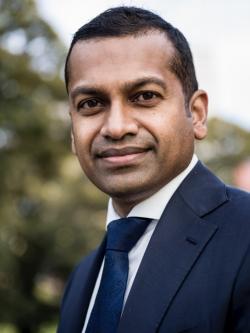It took Fulbright Scholar and Honorary UTS Fellow Gayan Benedict 20 years to commit to a PhD. But once he found the time and topic, he realised the value of bringing decades of industry networks, experience and knowledge into his research.

Image from iStock
Gayan Benedict has always found himself drawn to the tension that emerges from major technological change from pre-internet to internet; web to mobile; the current shift to generative AI.
Sitting at this intersection throughout his career, Gayan’s resume includes executive leadership roles across the Reserve Bank of Australia (RBA), Westpac and Salesforce Australia.
In 2017, he was driven to research the challenges that the booming cryptocurrency payments presented to financial system stability and regulation in Australia through the UTS industry doctorate program. At the time, Gayan was the Deputy Chief Information Officer (CIO) of the Reserve Bank of Australia (RBA).
Then, around the time that the cryptocurrency bubble grew and subsequently burst, Gayan was promoted to CIO.
“I asked myself if I should pause, defer or slow down the research. But then I had the sense that there will never be a perfect time for it. So, I just decided to keep powering away with it and managed to make it work.”
Finding your research sweet spot

This wasn’t Gayan’s first time attempting a research degree.
“I had made an earlier attempt at doing a PhD about 20 years ago. At the time it was hard juggling even part-time
studying with a full-time industry role. Universities then, I think, were also less set up to drive industry-aligned research in technology and banking.”
But then he received the advice to think about a research topic that would be impactful and relevant to his organisation.
“The RBA obviously does a lot of policy work which is mostly in the economic, banking and payments areas. In the 2010s, cryptocurrency was a technology field that was also increasingly relevant to central bank policy and accountabilities.
“For me it was a field that allowed me to pursue my interest in technology research and align it to a direct responsibility of my organisation.”
“Ensuring the research outcomes and my role as CIO were constantly aligned was key. It meant I could spend an hour on a blockchain matter relevant to my CIO position and it also benefitted my research priorities.”
Industry-led from the start
Undertaking his industry research while working at the RBA placed Gayan in an excellent position to engage with stakeholders in his research topic.
“A big part of the research was really understanding the current and likely future challenges of cryptocurrency. As part of my role in the RBA I worked with financial regulators, banks, financial service providers and fintech innovators who were interested in the same issues. They were involved in coming up with the problems, looking at solutions and validating the product that came at the end of it.
“I’ve always had the philosophy of bringing industry input into the design of the research problem upfront.
“For me that maximises its chance of practical adoption because it's been almost co-created with industry from the very beginning.”
Gayan used an approach called Participatory Action Design Research, a scientifically rigorous approach to solving cutting-edge problems with industry experts. At the time of Gayan’s research, it was a relatively novel approach for determining regulatory responses to emerging technology.
“It’s an extension of a conventional Action Design Research method, but no one had used it in the blockchain regulation context,” Gayan explains.
He’s using the same approach on his recent research into the regulatory response to AI-enabled blockchains, for which he undertook a Fulbright scholarship at Georgetown University in Washington D.C..
Fusing industry, academia & unique skills
Despite forging a career in the technology sector, Gayan isn’t deeply technical.
“I describe myself as the world's worst coder,” he laughs.
“I steered my career more towards design and architecture. I’m a much better communicator than developer so I can translate development concerns and challenges to business folk and business requirements to developers.”
While this skill has led him to success in leadership positions, it is also why he was able to blend multiple disciplines for his PhD.
“My research is at the intersection of law, regulation and financial systems rather than the pure technology itself.”
Now finished with his PhD, Gayan works as the CTO of Salesforce Australia where he still draws on his PhD experience.
“Technology regulation and security compliance is a common theme in the tech sector and all other industries that rely on technology. So having a familiarity with the regulatory landscape and how to balance risk and innovation is very helpful.”
Gayan describes his other roles – as honorary industry research fellows at UTS and MIT – as his hobby. His current research on the risks of AI-enabled blockchains is helping solidify him as a leader in the space of exploring and using emerging technologies while minimising the risks they pose to humanity.
What topic aligns your interests with your company’s? Explore our Industry Doctorate Program ->

